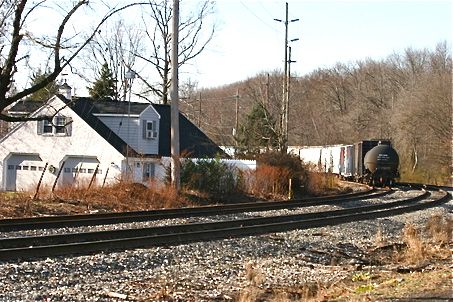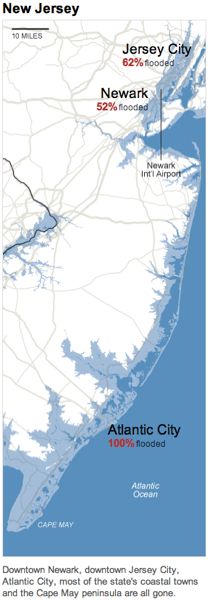Toxic Chemicals Released In South Jersey Train Accident Force Evacuation

Repauno, NJ - residential neighborhood within feet of chlorine rail tanker cars. Tanker cars were easily accessible and unprotected. Chlorine gas release would be deadly. (1/18/08)
Do You Live in the “Kill Zone”?
[Important update below]
The Star Ledger is reporting that earlier this morning, a train derailed and spilled toxic chemicals that caused breathing difficulties among at least 18 people and forced evacuation of the area, see: Paulsboro bridge collapse derails train, dumps tank car contents into Mantua Creek
This accident opens personal wounds.
On a policy level, it reminds us of real threats to our lives that require more aggressive regulation.
On a personal note, I have been down in that area and wrote about exactly these kind of risks as accidents waiting to happen, see: In Harm’s Way (hit the link and scroll down to see photos of unsecured trains with toxic loads near schools and daycare centers).
For taking those and other photos in Paulsboro, I was detained by local police, my car was illegally searched and my documents were seized, and I was later investigated by federal Homeland Security and the FBI.
A few days after the incident, three investigators came to my house: Homeland Security, FBI and the Hunterdon County Prosecutor’s Office.
At one point, while the focus of the investigation was on my photography of oil refineries, one of the investigators mentioned that I had been seen taking photos of train cars and chemical plants near schools, that I had a backpack on at the time, and suggested that I might be a terrorist seeking to emulate the “Chechen Rebels”.
I think I remain on a US domestic terror watch list as a result of this incident and investigation.
On a policy level, this accident reminds us that the chemical industry is creating unacceptable risks that require more stringent regulation (see: 25 Years After Bhopal Chemical Disaster: NJ”s “Fatal Fifteen” Shows it Can Happen Here
But instead of stricter regulation, under the Governor’s Executive Order #2, to appease the chemical industry, the Christie Administration is going in the opposite direction and rolling back NJ’s stringent state requirements to federal minimums.
The Whitman Administration tried and was warned not to do this way back in 1994, when a DEP Assistant Commissioner wrote this:
“Industry (e.g., CIC and NJBIA) would obviously prefer backing off to the EPA thresholds. However, the increases made by EPA on adoption were so large (averaging some 18 times the TCPA values with 33 of the 60 substances common to both lists assigned from 5 to 167 times corresponding TCPA values) that they are not technically justifiable in an area as densely populated as New Jersey where substances are generally handled on small sites, and would correlate with a significant increase in the number of potential fatalities.”
NJ industries use over 15 BILLION pounds of hazardous chemicals per year. That number has grown slightly from 1990 – 1998 (most recent data reported by DEP Pollution Prevention). That’s almost 2,000 pounds for each resident.
Hundreds of NJ Communities are threatened by scores of dangerous chemical facilities, where an accident or terror attack could kill more than 100,000 residents.
While this spill may have been minor, it also reminds us that the liability cap for such spills still is far too low and legislation to raise it is stalled due to the political power of the chemical industry. (correction – see update below!)
The public interest and community safety are being sacrificed and put at needless risk as a result of the political power of the chemical industry –
While we may have dodged a bullet with what appears to be a relatively minor train wreck, it could have been far worse. [correction – see update below]
When will warnings be heeded? After people die?
[Update: It looks like EPA is downplaying the risks of the chemical released, vinyl chloride.
According to ATSDR “Tox Facts” VC is one of the few chemicals that are known human carcinogens – that relates to long term chronic exposures.
For acute exposure, I didn’t see EPA mention “coma and death”, ATSDR reports:
Health Effects
- The primary target of vinyl chloride acute exposure is the CNS. Signs and symptoms include dizziness, ataxia, inebriation, fatigue, numbness and tingling of the extremities, visual disturbances, coma, and death.
- Vinyl chloride can irritate the eyes, mucous membranes, and respiratory tract. Escaping compressed gas or liquid can cause frostbite or irritation of the skin and eyes.
- Chronic exposure can cause permanent liver injury and liver cancer, neurologic or behavioral symptoms, and changes to the skin and bones of the hand.
- Vinyl chloride’s acute CNS effects are likely to be caused by interaction of the parent compound with neural membranes. Other effects appear to be caused by interaction of reactive intermediates with macromolecules.
(PS – the site is down the rive from me, 40 miles south, south west. I am feeling a tad dizzy and nauseous just now and checked the weather – sure enough, wind is from the SE. Could a cloud be blowing up the Delaware River?


